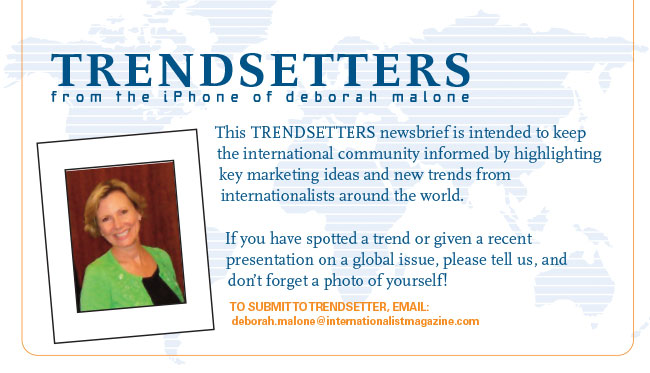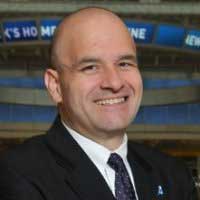


Marty St. George
Trendsetters: JetBlue's Marty St. George Shares the Strategies of a Challenger Brand
Marty St. George, Senior Vice President- Commercial of JetBlue Airways, admits that there is often a perception-reality disconnect in the airlines business. Speaking last week in Orlando to a record crowd of 2800 at the ANA's Masters of Marketing conference, both his quick wit and sharp intelligence punctuated his address on "Bringing Humanity Back to Air Travel."
He joked that few marketers would look to airlines for inspiration, particularly when, as a category, they rank among the lowest in customer satisfaction. Nonetheless, Mr. St. George had a number of key lessons to share in regard to social media savvy, brand voice, and understanding how employees can shape brand image. JetBlue has been a winner of 10 consecutive J.D. Power Awards for best airline in North America. Rather than boast about accolades, Marty St. George concentrates his efforts on marketing a service business where he must deliver on a differentiated customer experience—every day.
"Plus," he reminded the audience, "You buy an airline ticket, because you want to go somewhere… not because you want to be on a plane." Building brand preference against such a mindset isn't easy, particularly if you are a low-cost airline. Yet, JetBlue has done so.
He adds that the airline business also faces uncertainty at the core of its cost structure, which not only affects pricing, but marketing—particularly as a challenger brand. He admits, "I have no idea what it will cost to fly to Florida six months from now." Fuel, the biggest expense for any carrier, is a factor over which airlines have no control. In addition to his marketing responsibilities, Marty St. George is also now charged with Pricing, Revenue Management, Sales and Cargo.
He outlines how there has been a commoditization of the airline business today as more carriers eliminate services in coach or simply charge for basics as a way of managing these cost fluctuations. JetBlue was built on providing more for the average flyer in an era of reductions. "We aim to give you the best possible experience when you fly JetBlue-- with 100 free channels of Direct TV, XM radio, unlimited snacks, and even a whole can of soda."
He also talks about how the company rallies around five values that are essential to the brand: Safety, Caring, Integrity, Fun, and Passion. "Every employee knows these values. We believe in empowerment at every level at JetBlue. Every single staff member goes through orientation. Even our CEO introduces himself to all of the crewmembers. In essence, we're telling our teams: ‘You guys are the brand.'"
Yet with routes to 90 cities across North, Central and South America, and $6 billion in revenue, JetBlue "is still a minnow," according to Marty. American, Delta, United and Southwest together comprise 80% of the market for Americans, so he admits, "We're up again behemoths."
And minnows and behemoths have very different budgets. He adds, "We are outspent 15–to-1 by Southwest Airlines alone. Every dollar has to account for much more with us. We certainly can't compete by screaming. We are a different brand and we need a different voice. Our marketing filter has to be—‘Would only JetBlue do this?'" With an emphasis on driving "bookings, brand and buzz," one example is a concert series at JetBlue's JFK terminal in New York called "Live From T5," which has featured artists like Taylor Swift. The only way to see the concert is to buy a ticket on JetBlue.
However, it is the company's emphasis on both social media and seizing opportunities that form the backbone of its marketing strategies. Social media's real-time response has helped JetBlue deliver on its mission of "bringing humanity back to air travel." The airline focuses on adapting quickly to customer feedback—which can range from big issues to minor problems with a TV screen or tray table that still loom large as part of the passenger experience. Plus, the one-to-one connections with customers who want to engage has had a humanizing effect on the brand. Marty personally stays connected to as many people as possible, because he knows that these comments and conversations can provide insights to influence new JetBlue marketing initiatives.
One example of moving quickly and taking advantage of an opportunity is "Carmageddon," a suggestion by JetBlue's Corporate Counsel—which proves Marty's belief that good ideas can come from anyone-- as an alternative to the reconstruction of California's Interstate 405—arguably one of the world's busiest highways connecting Los Angeles and Orange County.
During the summer of 2011, Interstate 405 was closed for 10 days as part of major reconstruction project, which even Los Angeles' Mayor called an "absolute nightmare" for traffic. The press named the impending roadway disaster "Carmageddon." As a result, JetBlue offered 20-minute, round-trip flights from Long Beach to Burbank, which flew over the construction, for $4.05. (Of course, they sold out in a matter of hours.) According to Marty, the JetBlue alternative created 3 billion impressions, got the brand on every news outlet for its inventiveness, and built fans for life in LA.
Marty St. George joined JetBlue in 2006 after a career at United Airlines where he had most recently served as Managing Director of Marketing Planning. He is a 25 year veteran of the airline business with roles in marketing, brand and corporate strategy. He graduated with a degree in civil engineering from the Massachusetts Institute of Technology, and the marketing community is delighted that he strayed from his first field of engineering.
